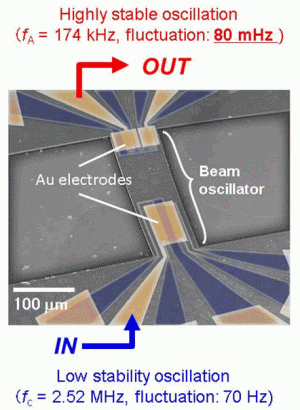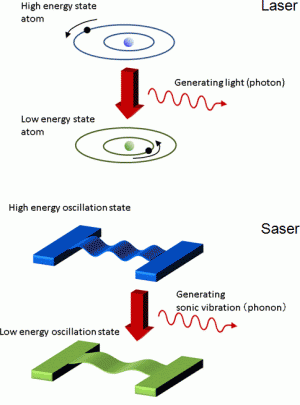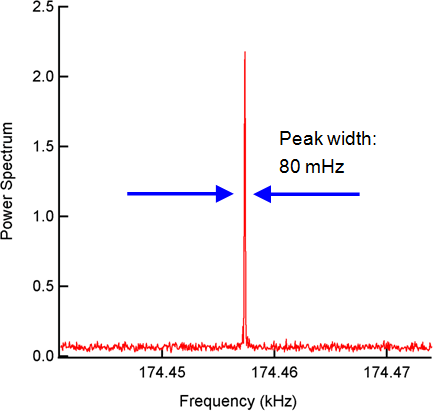'Lasing' operation in an ultrasonic vibration using a MEMS oscillator

Nippon Telegraph and Telephone Corporation has succeeded in fabricating a novel ultrasonic oscillator by applying a principle analogous to an optical laser, which is widely used as a highly purified light source, to a microelectromechanical systems (MEMS). The frequency purity of the output vibration is less than 1 part in1,000,000.
This result will be published in the American science journal Physical Review Letters (dated March 18) demonstrating a micromechanical device working on a totally novel mechanism.
A Quartz crystal oscillator is a device that uses a mechanical resonance to create an electrical signal with high frequency stability. Thanks to its very high frequency purity, it is widely and indispensably used in telecommunication and information processing equipment. However, there is an enormous demand for higher operation frequencies in ever smaller packages in order to develop even faster and more integrated communication networks and infrastructures. NTT laboratories have been engaged in developing new applications for MEMS and its miniaturized counterpart NEMS. In this work, they have applied the operating principle of an optical laser to a micromechanical oscillator and have succeeded in observing a highly stable ultrasonic oscillation. At present, this is a "proof of principle" experiment but could be further miniaturized enabling the development of a higher frequency, and higher precision semiconductor on-chip oscillator than a Quartz crystal oscillator.

The oscillator structure
The essential part of the oscillator is a tiny 250-μm long, 85-μm wide, and 1.4-μm thick bar usually called a "beam" (Fig.1). By applying an operating protocol similar to that of an optical laser to this structure, the scientists succeeded in generating an ultrasonic vibration with a frequency fluctuation that is less than 1 part in 1,000,000. The type of device that generates a highly stable ultrasonic oscillation using similar principle to that of lasers is called a SASER, in analogy to a laser. The all-electrical operation of the SASER using MEMS was demonstrated for the first time in the world.
Technical points
1. Using the beam structure to play the role of an atom
In an optical laser, a photon is emitted from an atom when it relaxes from a high-energy state to a low-energy one [Fig. 2(a)]. In the newly developed SASER device, the role of the atom can be similarly played by the beam structure itself through the use of a high energy oscillation state and low energy one [Fig. 2(b)].

2. Precise control of the oscillation states using piezoelectricity
The oscillation states could be electrically optimized by using piezoelectricity in order to effectively induce the ultrasonic wave. The frequency purity was demonstrated by confirming the generation of a highly frequency-stable output oscillation. In contrast to the frequency fluctuation of 70 Hz in the input oscillation, the fluctuation in the output oscillation was only 80 mHz, being only one part in 2,000,000 of the oscillation frequency (Fig. 3). In addition, the output oscillation was only observed when the input voltage was larger than a specific value, that is, it showed the so called threshold characteristic commonly observed in optical lasers. These observations proved that a similar operating principle to that of laser was realized in the ultrasonic vibration using the beam structure.
In this experiment, operation with a similar stability in the oscillation to that of a Quartz crystal oscillator was confirmed at low temperature (2.0K) at a frequency of 174 kHz. The researchers plan to further miniaturize and optimize this structure and use more suitable materials in order to realize operation frequencies higher than 1 GHz at room temperature.
Journal information: Physical Review Letters
Source: NTT

















